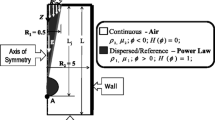Abstract
We propose a novel breakup model to simulate the catastrophic breakup regime in a supersonic cross flow. A developed model has been extended from an existing Kelvin-Helmholtz/Rayleigh-Taylor (K-H/R-T) hybrid model. A new mass reduction rate equation, which has critical effects on overall spray structure, is successfully adopted, and the breakup length, which is an important parameter in existing model, is replaced by the breakup initiation time. Measured data from the supersonic wind tunnel with a dimension of 762×152×127 mm was employed to validate the newly developed breakup model. A nonaerated injector with an orifice diameter of 0.5 mm is used to inject water into a supersonic flow prescribed by the momentum flux ratio of the liquid jet to free stream air, q 0 . The conservation-element and solution-element (CE/SE) method, a novel numerical framework for the general conservation law, is applied to simulate the supersonic compressible flow. The spray penetration height and average droplet size along with a spray penetration axis are quantitatively compared with data. The shock train flow structures induced by the presence of a liquid jet are further discussed.
Similar content being viewed by others
Abbreviations
- B 0 :
-
drop size — constant
- B 1 :
-
breakup time — constant
- C D :
-
drag coefficient
- D :
-
drag function or drop diameter
- d 0 :
-
nozzle diameter
- e :
-
specific internal energy
- E :
-
specific total energy
- h 0 :
-
penetration height
- M x, y, z :
-
Momentum exchange terms
- M s :
-
free stream Mach number
- m 0 :
-
initial mass
- m :
-
mass
- p :
-
pressure
- Q s :
-
energy exchange term
- r :
-
jet radius or drop radius
- Re:
-
Reynolds number
- T :
-
Taylor number
- t s :
-
breakup time
- We:
-
Weber number
- Z :
-
Ohnesorge number
- u, v, w :
-
flow velocities
- x, y, z :
-
spatial coordinates
- Λ:
-
wavelength of fastest growing wave
- ρ :
-
density
- σ :
-
surface tension coefficient
- τ :
-
liquid breakup time
- µ:
-
viscosity
- Ω :
-
maximum wave growth rate
- g :
-
gas
- k :
-
particle index
- l :
-
liquid
- 0 :
-
initial value
- T :
-
transpose matrix
References
Beale, J. C. and Reitz, R. (1999). Modeling spray atomization with the Kelvin-Helmholtz/Rayleigh-Taylor hybrid model. Atomization and Spray 9,6, 623–650.
Chen, T. H., Simith, C. R., Schommer, D. G. and Nejad, A. S. (1993). Multi-zone behavior of transverse liquid jet in high-speed flow. AIAA Paper 93-0453.
Crowe, C. T., Sommerfield, M. and Tsuii, Y. (1998). Multiphase Flows with Droplets and Particles. CRC Press LLC.
Dukowicz, J. K. (1980). A particle-fluid numerical model for liquid sprays. J. Computational Physics 35,2, 229–253.
Hinze, J. O. (1955). Fundamentals of the hydrodynamic mechanism of splitting in dispersion processes. AIChE J. 1,3, 289–295.
Hsiang, L.-P. and Faeth, G. M. (1992). Near-limit drop deformation and secondary breakup. Int. J. Multiphase Flow 18,5, 635–652.
Lin, K.-C., Kennedy, P. J. and Jackson, T. A. (2001). Spray structures of aerated-liquid jets in subsonic crossflows. AIAA Paper 2001-0330.
Lin, K.-C., Kennedy, P. J. and Jackson, T. A. (2004). Structures of water jets in a mach 1.94 supersonic crossflow. AIAA Paper 2004-0971.
Madabhushi, R. K. (2003). A model for numerical simulation of breakup of a liquid jet in crossflow. Atomization and Spray 13,4, 413–424.
O’Rourke, P. J. and Amsden, A. A. (1987). The TAB method for numerical calculation of spray droplet breakup. SAE Paper No. 872089.
Patterson, M. A. and Reitz, R. D. (1998). Modeling the effects of fuel spray characteristics on diesel engine combustion and emissions. SAE Paper No. 98031.
Pilch, M. and Erdman, C. A. (1987). Use of breakup time data and velocity history data to predict the maximum size of stable fragments for acceleration-induced breakup of a liquid drop. Int. J. Multiphase Flow, 13, 741–757.
Rachner, M., Becker, J., Hassa, C. and Doerr, T. (2002). Modelling of the atomization of a plain liquid fuel jet in crossflow at gas turbine conditions. Aerospace Science and Technology 6,7, 495–506.
Ranger, A. A. and Nicholls, J. A. (1969). Aerodynamic shattering of liquid drops. AIAA J., 7, 285–290.
Reinecke, W. G. and Waldman, G. D. (1970). A Study of Drop Breakup Behind Strong Shocks with Applications to Flight. AVCO Report AVSD-0110-70-RR.
Reitz, R. D. (1987). Modeling atomization processes in high-pressure vaporizing sprays. Atomisation and Spray Technology, 3, 309–337.
Ricart, L. M., Xin, J., Bower, G. R. and Reitz, R. D. (1997). In-cylinder measurement and modeling of liquid fuel spray penetration in a heavy-duty diesel engine. SAE Paper No. 970591.
Taylor, G. I. (1963). Aerodynamics and the Mechanics of Projectiles and Explosions. The Scientific Papers of G. I. Taylor Vol. III Edited by G. K. Batchelor.
Wu, P.-K., Kirkendall, K. A., Fuller, R. P. and Nejad, A. S. (1997). Breakup processes of liquid jets in subsonic crossflows. J. Propulsion and Power 13,1, 64–73.
Zhang, Z.-C., Yu, S.-T. and Chang, S.-C. (2002). A space-time conservation element and solution element method for solving the two- and three-dimensional unsteady euler equations using quadrilateral and hexahedral meshes. J. Computational Physics, 175, 168–199.
Author information
Authors and Affiliations
Corresponding author
Rights and permissions
About this article
Cite this article
Im, K.S., Lin, K.C., Lai, M.C. et al. Breakup modeling of a liquid jet in cross flow. Int.J Automot. Technol. 12, 489–496 (2011). https://doi.org/10.1007/s12239-011-0057-1
Received:
Revised:
Published:
Issue Date:
DOI: https://doi.org/10.1007/s12239-011-0057-1




